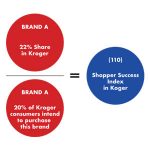 The Shopper Success Index (SSI) identifies the balance between a shopper’s likelihood to purchase a given brand and how well that brand performs at retail. In other words, it determines the ratio between the shopper’s “purchase intent” when not in the store, to the brand’s “on-the-shelf” market share. It is important because it identifies what kind of initiative should be pursued with the retailer.
The Shopper Success Index (SSI) identifies the balance between a shopper’s likelihood to purchase a given brand and how well that brand performs at retail. In other words, it determines the ratio between the shopper’s “purchase intent” when not in the store, to the brand’s “on-the-shelf” market share. It is important because it identifies what kind of initiative should be pursued with the retailer.
Category: SHOPPER DIY
PLANNING & BUDGET
PLANNING & BUDGET What is your Shopper situation?
Five analytical steps are keys to success
PLANNING & BUDGET What is a Shopper opportunity?
Every interaction can touch emotions
 Identifying Shopper opportunities depends on business-based insights that consider brand and retailer objectives in tandem, and how those interests align with the consumer’s. While the overarching goal is to trigger favorable purchasing decisions when the consumer is in shopping mode, the scope is much larger, as it includes creating positive brand experiences at every touchpoint, regardless of whether a transaction is involved.
Identifying Shopper opportunities depends on business-based insights that consider brand and retailer objectives in tandem, and how those interests align with the consumer’s. While the overarching goal is to trigger favorable purchasing decisions when the consumer is in shopping mode, the scope is much larger, as it includes creating positive brand experiences at every touchpoint, regardless of whether a transaction is involved.
SHOPPER EXPLAINED How is Shopper organized?
True Shopper is cross-functional
 Shopper must be fully integrated throughout the organization, because consideration of how and why shoppers decide what to buy is critical to the success of our enterprise in total. Shopper functions as part of the marketing department, with integrated, cross-functional brand teams composed of Sales, Marketing, Insights, Category Management and Shopper managers, who are dedicated to long-term collaboration with a select group of retailers.
Shopper must be fully integrated throughout the organization, because consideration of how and why shoppers decide what to buy is critical to the success of our enterprise in total. Shopper functions as part of the marketing department, with integrated, cross-functional brand teams composed of Sales, Marketing, Insights, Category Management and Shopper managers, who are dedicated to long-term collaboration with a select group of retailers.
ORGANIZATIONAL DESIGN How should Shopper be integrated?
Bring a shopper focus to brand strategy
 Brand groups must be re-designed to bring a shopper focus to the brand strategy. This requires establishing a Shopper function within Marketing that is simultaneously brand- and retailer-facing. This will ensure that the brand strategy is fully aligned with the shopper’s behavior within specific retailers.
Brand groups must be re-designed to bring a shopper focus to the brand strategy. This requires establishing a Shopper function within Marketing that is simultaneously brand- and retailer-facing. This will ensure that the brand strategy is fully aligned with the shopper’s behavior within specific retailers.

